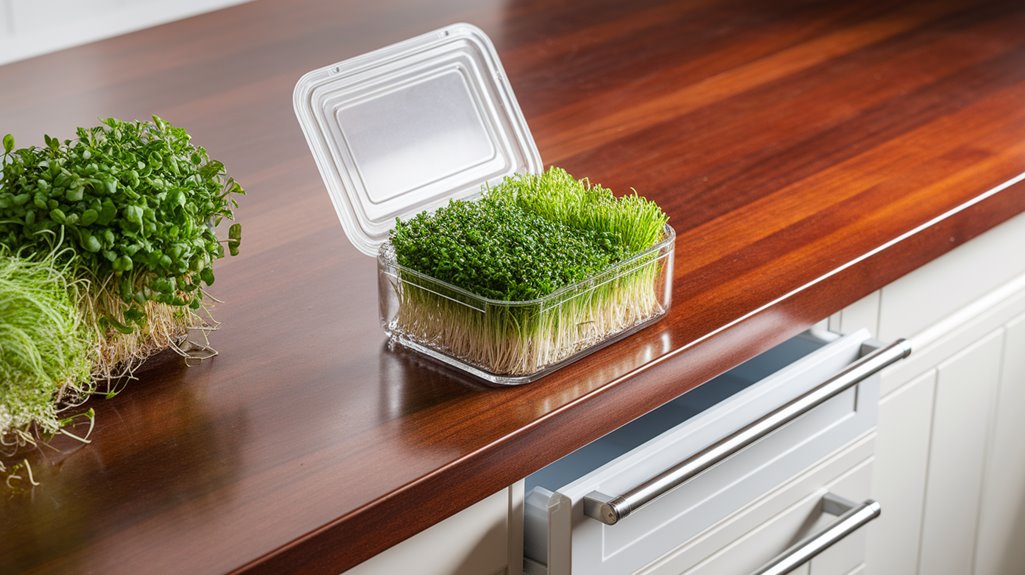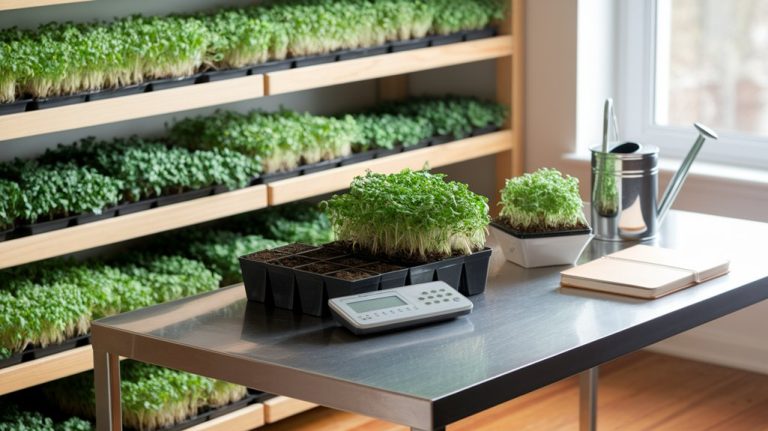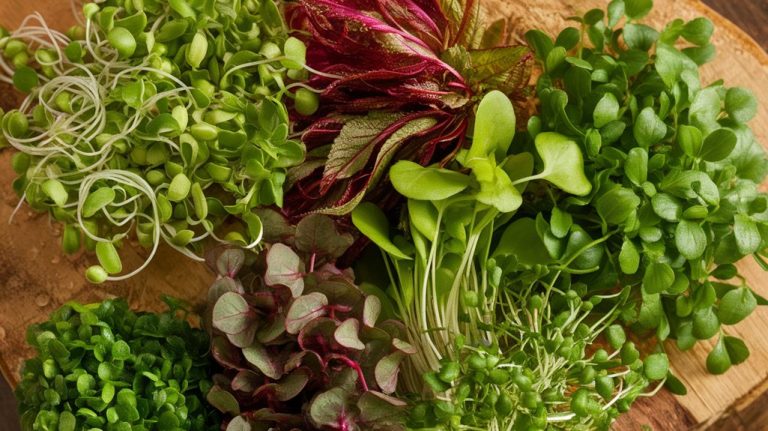How to Store and Freeze Microgreens Without Losing Nutrients
To store and freeze microgreens without losing nutrients, I recommend using breathable containers and keeping them in a cool, dark place like the fridge. When freezing, gently rinse and dry them, then flash freeze in a single layer on a baking sheet before transferring to airtight bags. To revive them, thaw overnight in the fridge or soak in cold water for about 15 minutes. If you want tips on incorporating them into your meals, I’ve got more to share.
Key Takeaways
- Store microgreens in breathable containers in a cool, dark place, preferably the fridge, to maintain freshness and nutrients.
- Avoid washing microgreens until ready to eat to retain their nutritional value and prevent moisture buildup.
- Flash freeze microgreens in a single layer on a parchment-lined baking sheet to preserve texture and nutrients.
- Use airtight containers or freezer bags, removing air to prevent freezer burn and maintain quality during storage.
- Thaw microgreens in the fridge or use cold water soaking to retain nutrients and enhance flavor before consumption.
Understanding Microgreens and Their Nutritional Value
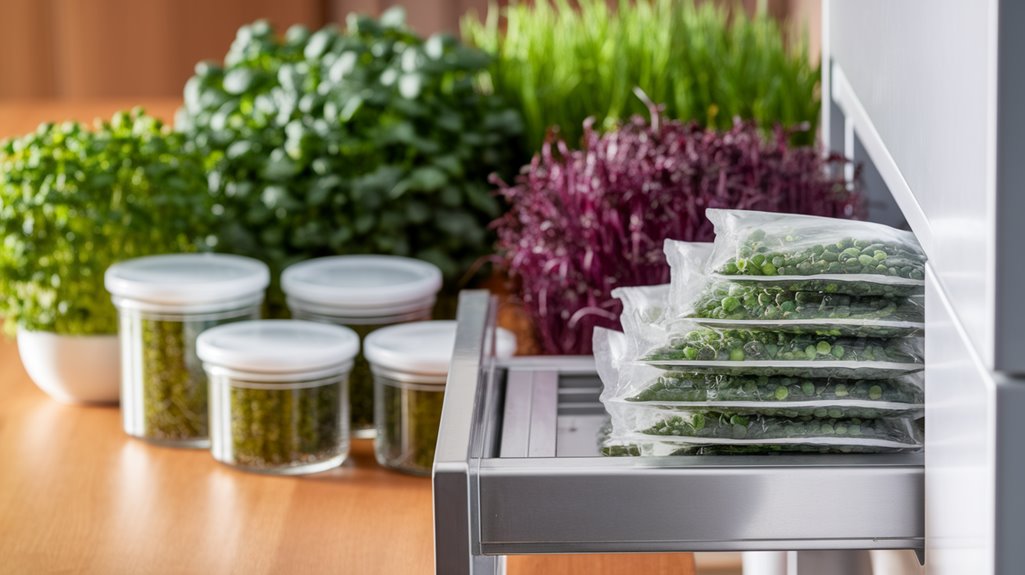
While many people might think of greens as merely a salad staple, microgreens offer a concentrated source of nutrients that can elevate any dish. These tiny plants, harvested just after their first true leaves develop, pack a punch of vitamins, minerals, and antioxidants.
Research shows that microgreens can contain up to 40 times more nutrients than their mature counterparts. For instance, red cabbage microgreens are rich in vitamin C and K, while sunflower microgreens provide healthy fats and protein.
Incorporating them into your meals can boost nutritional value and add vibrant flavors. I love tossing them into sandwiches, smoothies, or omelets.
Understanding their benefits can inspire you to experiment and enhance your culinary creations with these nutrient-dense wonders.
Best Practices for Storing Fresh Microgreens
To ensure your microgreens stay fresh and maintain their vibrant nutrients, it’s essential to store them properly right after harvesting.
I’ve found that following a few best practices can make a significant difference in the longevity and quality of these delicate greens.
- Use breathable containers to prevent moisture buildup.
- Keep them in a cool, dark place, like the fridge.
- Avoid stacking them too tightly to prevent bruising.
- Consume within a week for optimal flavor and nutrition.
- Don’t wash until you’re ready to eat to retain their freshness.
How to Properly Wash and Dry Microgreens
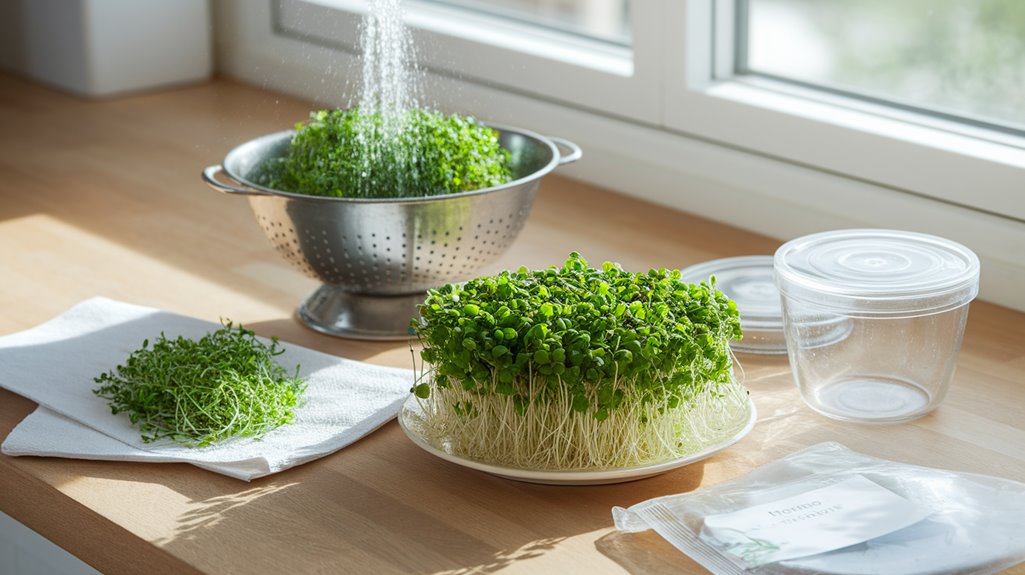
When it comes to washing and drying microgreens, proper technique is crucial to preserving their delicate texture and nutrients. I start by filling a clean bowl with cool water and gently submerging the microgreens.
It’s essential to avoid aggressive agitation, as this can damage the leaves. After a few minutes, I lift the microgreens out, allowing dirt and debris to settle at the bottom.
Next, I rinse them under cool running water, ensuring all contaminants are removed.
To dry them, I use a salad spinner for efficiency, but if I don’t have one, I lay them on a clean kitchen towel and pat them gently.
This careful washing and drying process helps maintain their vibrant flavor and nutritional value.
Freezing Microgreens: Step-by-Step Guide
When I freeze microgreens, I focus on two key steps: preparing them properly and using the right freezing techniques.
This ensures they maintain their flavor and nutritional value.
Let’s explore how to effectively freeze microgreens for future use.
Preparing Microgreens for Freezing
Preparing microgreens for freezing involves a few straightforward steps to ensure they retain their flavor and nutritional value.
First, I rinse the microgreens gently under cool water to remove any dirt or debris. Next, I pat them dry with a clean towel, making sure not to crush them. After that, I trim any damaged leaves, as these can affect the overall quality.
Here’s what I consider essential during preparation:
- Freshness is key; use only the best microgreens.
- Keep the moisture content low to prevent freezer burn.
- Handle them delicately to avoid bruising.
- Organize by type for easier use later.
- Label containers clearly to track different varieties.
These steps help maintain the vibrant taste and nutrients of your microgreens.
Proper Freezing Techniques
After I’ve prepared the microgreens, the next step is freezing them properly to lock in their flavor and nutrients.
First, I spread the microgreens in a single layer on a baking sheet lined with parchment paper. This prevents them from clumping together.
Next, I flash freeze them for about two hours until they’re solid.
Once frozen, I transfer the microgreens into airtight freezer bags or containers, removing as much air as possible to prevent freezer burn.
I label each bag with the date and type of microgreen.
For optimal nutrient retention, I aim to use them within six months.
Tips for Reviving Frozen Microgreens
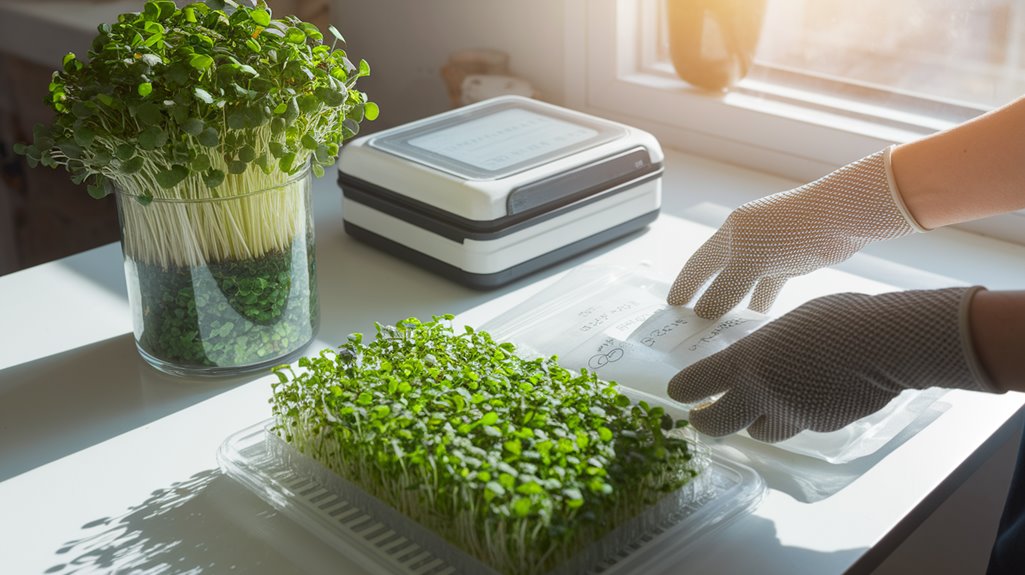
When it comes to reviving frozen microgreens, I’ve found that the right thawing techniques are crucial.
Using methods like water soaking can enhance their texture and flavor, while exposing them to light can boost their vibrancy.
Let’s explore these practical approaches to ensure your microgreens regain their freshness.
Thawing Techniques Explained
How do I effectively revive frozen microgreens? The right thawing techniques can make all the difference in preserving their flavor and nutrients. Here’s how I do it:
- I gently remove them from the freezer, feeling the anticipation of fresh greens.
- I place them in the fridge overnight, allowing them to thaw slowly.
- I avoid using heat, as it can wilt their delicate structure.
- I inspect them for any moisture, ensuring they stay fresh and crisp.
- I feel a sense of accomplishment as I prepare to add them to my dishes, knowing they’ll still pack a nutritious punch.
Using these methods helps maintain their vibrant taste and essential nutrients so I can enjoy their benefits fully.
Water Soaking Method
One effective method I use to revive frozen microgreens is the water soaking technique, which can quickly restore their freshness. Here’s how I do it:
- Take the frozen microgreens and place them in a bowl.
- Fill the bowl with cold water until the microgreens are fully submerged.
- Soak for about 10-15 minutes.
- Drain the water and gently pat dry.
This method helps to rehydrate the microgreens efficiently, making them crisp and palatable again. Below is a simple table summarizing the process:
| Step | Action | Time |
|---|---|---|
| 1 | Place microgreens in bowl | – |
| 2 | Submerge in cold water | – |
| 3 | Soak | 10-15 min |
| 4 | Drain and pat dry | – |
Light Exposure Benefits
While soaking frozen microgreens in water helps revive their texture, exposing them to light can further enhance their freshness and flavor.
When I place my thawed microgreens under a light source, I notice a significant boost in their vibrant color and nutrient content. This process simulates natural growth conditions, allowing them to regain some of their lost vigor.
Here are some benefits I’ve observed:
- Increased chlorophyll production, promoting a deeper green hue
- Enhanced nutrient absorption, revitalizing their health benefits
- Improved flavor profile, making them taste fresher and more robust
- Stimulated growth of antioxidants, safeguarding their nutritional value
- Aesthetic appeal, brightening up any dish with their vivid colors
Utilizing light effectively can truly transform your frozen microgreens!
Creative Ways to Incorporate Microgreens Into Your Meals
Incorporating microgreens into meals not only enhances flavor but also boosts nutritional value, making them a versatile addition to any dish.
I love adding them to salads for a fresh crunch or sprinkling them on top of soups for an extra layer of taste. They’re also fantastic in smoothies; just a small handful can elevate the nutrient profile significantly.
When I make omelets or scrambled eggs, I toss in some microgreens right before serving for a pop of color and nutrients.
For sandwiches and wraps, they replace traditional lettuce, offering more vitamins and minerals.
Experimenting with different varieties like radish or basil microgreens can yield exciting flavors, ensuring every meal is both delicious and healthful.
Frequently Asked Questions
Conclusion
In conclusion, by understanding the nutritional value of microgreens and following the best practices for storage and freezing, you can preserve their health benefits effectively. Proper washing and drying are crucial before freezing, ensuring minimal nutrient loss. When you’re ready to use your frozen microgreens, reviving them is simple and can enhance your meals. I encourage you to experiment with these vibrant greens, as they offer not only nutrition but also a burst of flavor in your dishes.

